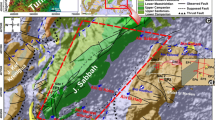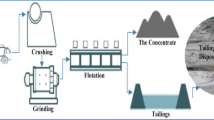Abstract
Weathering in humid, tropical regions generate cracks in the rock mass. The resultant cracks promote the infiltration of water into the rock mass and are the key source of water accumulation in rock pores and joints. This necessitates the regional information of spatially distributed water-saturated zone for a feasibility assessment of the deposit before development in such tropical regions. Traditional techniques such as drilling suffer several limitations such as data coverage, time, and cost. As the cores provide point-based information, therefore, even a large number of boreholes are insufficient for comprehensive subsurface hydrogeological investigations due to unidentified subsurface geology in the gaps between the boreholes. This paper presents an integrated two-dimensional electrical resistivity tomography (2D ERT), borehole, and aerial photogrammetry survey for detailed recognition of water-saturated zone in granite deposits. In line with this, the influence of the water-saturated zone on explosive selection for better extraction of rock aggregate is also discussed in this paper. Based on a successful demonstration of 2D ERT, a water-filled subsurface layer with resistivity values 100–300 Ωm were found in higher concentration in the study area. However, 2D ERT independently may give an ambiguous interpretation due to the overlapping resistivity values of the topsoil (100 to 800 Ωm) and the water-saturated zone (100 to 300 Ωm). 2D ERT was applied alongside the coring technique in this research work to raise the confidence in the obtained subsurface geological model. Meanwhile, to understand the surface topography of the study area, an aerial photogrammetry survey was performed. The integrated 2D ERT, borehole, and aerial photogrammetry approach allows for obtaining a detailed surface topography and continuous subsurface geological model. Thus, based on this research work, it is concluded that 2D ERT in conjunction with borehole survey is a rapid, inexpensive, and reliable technique for recognition of the water-saturated zone in regions with wet tropical climates.











Similar content being viewed by others
References
Aizebeokhai AP, Ogungbade O, Oyeyemi KD (2021) Application of geoelectrical resistivity for delineating crystalline basement aquifers in Basiri Ado-Ekiti, Southwestern Nigeria. Arab J Geosci 14:1–13
Aizebeokhai AP, Oyeyemi KD, Joel ES (2016) Groundwater potential assessment in a sedimentary terrain, southwestern Nigeria. Arab J Geosci 9:1–15
Almadani S, Ibrahim E, Al-Amri A, Fnais M, Abdelrahman K (2019) Delineation of a fractured granite aquifer in the Alwadeen area, Southwest Saudi Arabia using a geoelectrical resistivity survey. Arab J Geosci 12:1–13
Almadani S, Ibrahim E, Hafez M, Alfaifi H, Alharbi T, Abdelrahman K, Abdel-Motaal E (2018) Geotechnical investigation of the El-Elb dam site, northwest Riyadh, Saudi Arabia, using 2D resistivity and ground-penetrating radar techniques. Arab J Geosci 11:33
Attwa M, Ali H (2018) Resistivity characterization of aquifer in coastal semiarid areas: an approach for hydrogeological evaluation. Groundwater in the Nile Delta, pp 213–33
Batayneh AT (2006) Use of electrical resistivity methods for detecting subsurface fresh and saline water and delineating their interfacial configuration: a case study of the eastern Dead Sea coastal aquifers Jordan. Hydrogeol J 14:1277–1283
Bharti AK, Pal SK, Priyam P, Pathak VK, Kumar R, Ranjan SK (2016) Detection of illegal mine voids using electrical resistivity tomography: the case-study of Raniganj coalfield (India). Eng Geol 213:120–132
Smith MR, Collis L (2001) Aggregates: sand, gravel and crushed rock aggregates for construction purposes
Coulibaly Y, Belem T, Cheng LiZhen (2017) Numerical analysis and geophysical monitoring for stability assessment of the Northwest tailings dam at Westwood Mine. Int J Min Sci Technol 27:701–710
Farhadian H, Nikvar-Hassani A (2019) Water flow into tunnels in discontinuous rock: a short critical review of the analytical solution of the art. Bull Eng Geol Env 78:3833–3849
Gao Q, Shang Y, Hasan M, Jin W, Yang P (2018) Evaluation of a weathered rock aquifer using ERT method in South Guangdong, China. Water 10:293
Giang NV, Kochanek K, Vu NT, Duan NB (2018) Landfill leachate assessment by hydrological and geophysical data: case study NamSon, Hanoi, Vietnam. Journal of Material Cycles and Waste Management 1–15
Himi M, Rodríguez-Fernández D, Folch A, Lovera R, Domènech C, Rosell M, Rivero L, Otero N, Palau J, Fernàndez-Garcia D (2017) Hydrogeological and geophysical characterization of fractured aquifer of Òdena (Barcelona, Catalunya). In 23rd European Meeting of Environmental and Engineering Geophysics
Hutchison CS, Tan DNK (2009) Geology of Peninsular Malaysia. The University of Malaya and the Geological Society of Malaysia, Kuala Lumpur, pp 479
Ikard SJ, Rittgers J, Revil A, Mooney MA (2015) Geophysical investigation of seepage beneath an earthen dam. Groundwater 53:238–250
Ishak MF, Zaini MSI, Zolkepli MF, Wahap MS, Jaafar JI Sidek, Mohd Yasin A, Zolkepli MN, Mohmad Sidik MH, Mohd Arof KZ, Abu Talib Z (2020) Granite exploration by using electrical resistivity imaging (ERI): a case study in Johor. Int J Integr Eng 12: 328-47
Junaid M, Abdullah RA, Sa’ari R, Ali W, Rehman H, Alel MNA, Ghani U (2021) 2d electrical resistivity tomography an advance and expeditious exploration technique for current challenges to mineral industry. J Himalayan Earth Sci 54:11–32
Junaid M, Abdullah RA, Saa'ri R, Alel M, Ali W, Ullah A (2019) Recognition of boulder in granite deposit using integrated borehole and 2D electrical resistivity imaging for effective mine planning and development
Lesparre N, Boyle A, Grychtol B, Cabrera J, Marteau J, Adler A (2016) Electrical resistivity imaging in transmission between surface and underground tunnel for fault characterization. J Appl Geophys 128:163–178
Loperte A, Soldovieri F, Palombo A, Santini F, Lapenna V (2016) An integrated geophysical approach for water infiltration detection and characterization at Monte Cotugno rock-fill dam (southern Italy). Eng Geol 211:162–170
Manu E, Agyekum WA, Duah AA, Tagoe R, Preko K (2019) Application of vertical electrical sounding for groundwater exploration of Cape coast municipality in the central region of Ghana. Arab J Geosci 12:1–11
Mehmood Z, Khan NM, Sadiq S, Mandokhail S-U, Ashiq SZ (2020) Assessment of subsurface lithology, groundwater depth, and quality of UET Lahore Pakistan, Using Electrical Resistivity Method. Arab J Geosci 13:1–7
Metwaly M, AlFouzan F (2013) Application of 2-D geoelectrical resistivity tomography for subsurface cavity detection in the eastern part of Saudi Arabia. Geosci Front 4:469–476
Mojica A, Pérez T, Toral J, Miranda R, Franceschi P, Calderón C, Vergara F (2017) Shallow electrical resistivity imaging of the Limón fault, Chagres River Watershed, Panama Canal. J Appl Geophys 138:135–142
Niaz A, Khan MR, Ijaz U, Yasin M, Hameed F (2018) Determination of groundwater potential by using geoelectrical method and petrographic analysis in Rawalakot and adjacent areas of Azad Kashmir, sub-Himalayas Pakistan. Arab J Geosci 11:1–13
Olayinka AI, Yaramanci U (2000) Use of block inversion in the 2-D interpretation of apparent resistivity data and its comparison with smooth inversion. J Appl Geophys 45:63–81
Samouelian A, Cousin I, Tabbagh A, Bruand A, Richard G (2005) Electrical resistivity survey in soil science: a review. Soil Tillage Res 83:173–193
Shi JS, Wu LZ, Wu SR, Li B, Wang T, Xin P (2016) Analysis of the causes of large-scale loess landslides in Baoji China. Geomorphology 264:109–117
Strelec S, Mesec J, Grabar K, Jug J (2017) Implementation of in-situ and geophysical investigation methods (ERT & MASW) with the purpose to determine 2D profile of landslide. Acta Montanistica Slovaca 22:345
Uhlemann SS, Chambers JE, Hagedorn S, Maurer H, Wilkinson PB, Dijkstra TA, Dashwood B, Merritt A, Gunn DA (2015) Structurally constrained 4D ERT monitoring to image hydrological processes leading to landslide reactivation. In Near Surface Geoscience 2015-21st European Meeting of Environmental and Engineering Geophysics
Van Giang N, Ba Duan N (2017) Hydrogeophysical approach for contamination assessment in NamSon landfill, Hanoi. Vietnam. Arab J Geosci 10:377
Wardrop DR (2012) The accuracy of sand and gravel reserve estimates. Q J Eng GeolHydrogeol 45:243–247
Xu L, Dai FC, Tu XB, Javed I, Woodard MJ, Jin YL, Tham LG (2013) Occurrence of landsliding on slopes where flowsliding had previously occurred: an investigation in a loess platform. North-West China, Catena 104:195–209
Zeng RQ, Meng XM, Zhang FY, Wang SY, Cui ZJ, Zhang MS, Zhang Y, Chen G (2016) Characterizing hydrological processes on loess slopes using electrical resistivity tomography–A case study of the Heifangtai Terrace, Northwest China. J Hydrol 541:742–753
Acknowledgements
We highly appreciate the valuable suggestions provided by the anonymous reviewers that improved the paper a lot.
Funding
The research work was jointly funded by Higher Education Commission (HEC) Pakistan under HRD scheme and Universiti Teknologi Malaysia.
Author information
Authors and Affiliations
Corresponding author
Ethics declarations
Conflict of interest
The authors declare no competing interests.
Additional information
Responsible Editor: Amjad Kallel
Rights and permissions
About this article
Cite this article
Junaid, M., Abdullah, R.A., Sa’ari, R. et al. Water-saturated zone recognition using integrated 2D electrical resistivity tomography, borehole, and aerial photogrammetry in granite deposit, Malaysia. Arab J Geosci 15, 1301 (2022). https://doi.org/10.1007/s12517-022-10572-x
Received:
Accepted:
Published:
DOI: https://doi.org/10.1007/s12517-022-10572-x




